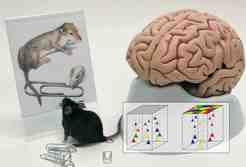Fuente: Max-Planck-Gesellschaft - Forschung
Expuesto el: martes, 22 de mayo de 2012 10:45
Autor: Max-Planck-Gesellschaft
Asunto: The living fossils of brain evolution
The living fossils of brain evolution Göttingen scientists reconstruct a radical change during the evolution of the brain May 22, 2012 In the course of its evolution, the architecture of the mouse brain may have barely changed. Similar to the tiny ancestors of modern mammals that lived about 80 million years ago, nerve cells in the mouse visual cortex are densely packed in a small area of the brain. However, during the subsequent evolution of larger brains the architecture of the cerebral cortex was radically restructured. This is the conclusion of an international team of researchers led by scientists at the Max Planck Institute for Dynamics and Self-Organization, the University of Göttingen and the Bernstein Center Göttingen. The brains of larger mammals, such as humans, however, have a completely different structure to those of mice. Processes of self-organisation led to the emergence of modules in which neurons conjointly are responsible for specific tasks. Ancestor (left) and descendant (right). The image shows a reconstruction of the common ancestor of all living mammals ... [more] Ancestor (left) and descendant (right). The image shows a reconstruction of the common ancestor of all living mammals (Hadrocodium wui) from the Early Jurassic, which has the size of a paper clip. Right, a model of a human brain. In terms of brain organisation, the mouse (centre) is probably a "living fossil". The diagrams to the right show a mixed (right) and a modular ordered structure of nerve cells in the cortex. © MPIDS Humans are considerably larger than almost all of their ancestors. Our great-great-great-grandparents were on average about 10 centimetres shorter than us. Going further back in time, the difference increases impressively. The ancestors of humans, and modern mammals in general, that lived 80 million years ago all weighed less than 100 grams and were usually only a few centimetres in size. Ecological niches that would have allowed a larger body were occupied by dinosaurs. Only the great extinction that wiped out the dinosaurs 65 million years ago allowed our ancestors a "growth spurt" of historical dimensions. Within just a few million years mammals evolved that were more than 100 times as large as their Mesozoic ancestors. A well-known international team of scientists led by Max Planck researchers reports in the journal Science that this growth spurt probably led to a fundamental reshaping of neural circuits in the brain. Scientists from the Goethe University in Frankfurt and their international partners hwere also involved in the study. As the researchers discovered, neural circuits in the visual cortex of the brain, corresponding to the smallest details, developed independently in different lineages. Computer simulations and mathematical calculations show that this correspondence reflects basic laws of self-organisation of large-scale neuronal networks. The researchers point towards the existence of "living fossils of brain development". This refers to species which preserved our ancestors' neuronal circuits' architecture until today. Among them, amazingly, is also one of the closest relatives of primates: the mouse. An essential aspect of human evolution was the enlargement of the brain and especially of the cerebral cortex, whose tasks include conscious perception, decision making, and many memory processes. This brain area in humans – as in many other mammals – is divided into modules in which groups of neurons are interconnected in dense networks and contribute to common tasks, such as the perception of a certain hue. The paper, which has been published in Science, analyses the evolution of what is known as orientation columns, modules of the visual cortex that build the basis of the perception of form. Hundreds of these modules, which typically have a size of about one millimetre, are located side by side within the visual cortex. The new study shows that this spatial orientation precisely follows geometric rules. Surprisingly, the same laws have evolved independently in separate lineages that led to the development of big brains and even in animals that differ greatly from each other in brain size. The new results thus refute a competing hypothesis that assumes strong dependencies of geometrical properties and brain size. It suggests that during a substantial period of the evolutionary enlargement of the brain only the number of modules increased. The laws of their arrangement, however, remained unchanged. The authors point out that these laws cannot apply for the entire phylogeny. Wolfgang Keil, first author of the study explains: "In our Mesozoic ancestors, these rules of brain architecture must have reached their limits. Their brains were so tiny that not even a single module would have fitted in the cerebral cortex." Thus, the researchers consider it to be likely that our ancestors had a fundamentally different architecture of their visual cortex. In fact, all living mammals that are lighter than 100 grams seem to lack orientation columns completely. In mice, for example, nerve cells that process different tasks in the visual cortex are seemingly randomly mixed. Whether our brain architecture originates from a mixed or an even stranger brain organisation can only be deduced after further investigations, the researchers argue. An important task for future studies will be an investigation of laws that govern small brains. "In fact, there are many dark continents in terms of the architecture of the visual cortex in the different lineages of mammals," says Fred Wolf, head of the study at the Max Planck Institute for Dynamics and Self-Organization and the Bernstein Center for Computational Neuroscience. The scientists hope that their work will encourage colleagues around the world to help resolve this fundamental mystery of our origins.
|

